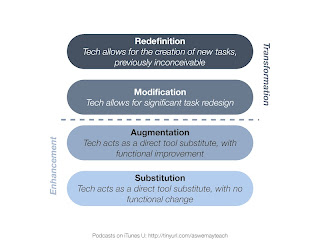 The hot new topic at Waukesha North High School is the SAMR model. This model was developed by Dr. Ruben Puentudura to guide teachers with integrating technology to increase overall student understanding, success, and achievement. With our one-to-one rollout for teachers coming on Thursday, I thought I would take a moment to reflect on my understanding of the SAMR model and solidify my thoughts before our journey gets on its way.
The hot new topic at Waukesha North High School is the SAMR model. This model was developed by Dr. Ruben Puentudura to guide teachers with integrating technology to increase overall student understanding, success, and achievement. With our one-to-one rollout for teachers coming on Thursday, I thought I would take a moment to reflect on my understanding of the SAMR model and solidify my thoughts before our journey gets on its way.The four levels of the SAMR model are as follows: Substitution, Augmentation, Modification, and Redefinition. The Substitution and Augmentation levels are part of the enhancement category in the SAMR model. The modification and redefinition levels are part of the transformation category in the SAMR model. The ultimate goal of the SAMR model is to transform what happens in the classroom in the modification and redefinition levels. Now with the terms outlined, let's take a closer look at what each on entails.
In the substitution level, the technology acts as a direct substitute. In this substitution, there is no functional change or enhancement to instruction. For example, let's say that you have a worksheet that you would like your students to complete. Rather than making a paper copy of the worksheet for your students, you could make the worksheet available on the iPad. At Waukesha North, I would convert my worksheet to a PDF and make a link to this document on my BlackBoard class website. When it was time for the students to use the worksheet, they would go to the BlackBoard site and click on the link to download the file. The worksheet would open up in a program like Notability and complete the worksheet as normal. The use of a stylus would be handy in this case. The worksheet and the activity don't change, just the way students see it.
The next level is augmentation. In this level the technology acts as a direct substitute, but offers some functional improvement. For example, I could create a short formative assessment using google forms. Students could complete this formative assessment as an entrance activity and submit their responses. I could then gather the responses and create flexible groups based on the data from the quick formative assessment. The use of the google form would allow the teacher to get data on each individual student and check for student understanding, rather than spot checking a few students. The technology is a direct substitute for a paper and pencil formative assessment, but the activity is enhanced because the teacher has immediate feedback and can then address the different abilities of students and progress from there.
In the modification level the technology allows for significant task redesign. For example, I could have students work in groups on an problem solving activity. The group could figure out how to solve the problem and then create a video, via an app such as Educreations, Explain Everything, etc., where they explain, step-by-step, how they solved the problem. The video could then be posted online (to a site such as BlackBoard) so that students could use it as a tutorial and study aid.
In the redefinition level the technology allows us to do things that were never before possible. As a teacher, you would not spend the majority of your time in the redefinition phase. I think if it as going to Grandma's house. You love to visit, you have a great time, but it's not someplace that you're ready to move. For example, you could have students create a portfolio of knowledge over a period of time (quarter, semester, year) using the Book Creator App. This portfolio can contain notes of important concepts and sample problems. This portfolio could serve as a quick reference guide for students to use after they leave the classroom. This would be especially handy in the math classroom because the content builds on itself. If a student needed a quick refresher, they could look at a quick one or two page summary. It would (hopefully) be easy for the student to understand because the student was the author.
Thank you Kristin. Your comments and examples are helpful; especially regarding Redefinition.
ReplyDelete